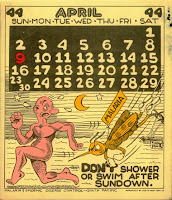An unofficial blog about the National Museum of Health and Medicine (nee the Army Medical Museum) in Silver Spring, MD. Visit for news about the museum, new projects, musing on the history of medicine and neat pictures.
Thursday, May 28, 2009
Able and Baker--the Space Monkeys
She did her duty and became a hero in our nation's space race. We have Able's skeleton in our Anatomical Collections--the Smithsonian has her pelt. She's not currently on display.
I hope you'll enjoy Baker & Able's story on NPR's site: http://www.npr.org/templates/story/story.php?storyId=104578202
Wednesday, May 27, 2009
Leprosy found in 4000 year old skeleton
A Skeleton 4,000 Years Old Bears Evidence of Leprosy
http://www.nytimes.com/2009/05/27/science/27leprosy.html
1512 alchemy book avaible online at NLM
NLM's History of Medicine Division is proud to announce that a new Turning the Pages Project has been released on the TTP kiosks in the Library and on the Web: http://archive.nlm.nih.gov/proj/ttp/books.htm.
The project features Hieronymus Brunschwig's Liber de Arte Distillandi, printed in Strasbourg in 1512. The book is a practical manual on chemical, alchemical, and distillation devices and techniques used to manufacture drug therapies, and it includes a number of hand-colored woodcuts featuring scenes of laboratories, distillation devices, and doctor patient scenes.
Special thanks to Anne Rothfeld, who curated the project, and Michael Chung, Glenn Pearson, and George Thoma, who created another visually beautiful project through their incomparable programming skills. Also special thanks to Roxanne Beatty for encoding the files for the gallery page.
Michael J. North, northm@mail.nih.gov
Head of Rare Books & Early Manuscripts
History of Medicine Division
National Library of Medicine
8600 Rockville Pike
Bethesda, MD 20894
Recycling
Yester-Day in the Life of an Archivist
Tuesday, May 26, 2009
AFIP's Armed Forces Medical Examiner featured in NY Times
And this bit is lovely - "“He was one of the most compassionate people throughout this whole process that I dealt with from the Department of Defense,” Mrs. Sweet said of Captain Mallak." I don't really know Craig Mallak all that well as OAFME's off in Rockville, MD but it's nice to read something that positive about someone.
Malaria Moe



Monday, May 25, 2009
Hospitals using Web2.0 to advertise
Webcast Your Brain Surgery? Hospitals See Marketing Tool
By PAM BELLUCK
Published: May 25, 2009
Hospitals are using Twitter from operating rooms, showing surgery on YouTube and having patients blog about their procedures, but ethics and privacy questions linger.
Friday, May 22, 2009
Yesterday was the Museum's 147th birthday
Yeah, we didn't notice either.
Virginia Museum of Fine Arts
Here's what I found in one of them:
Scene from the Epidemic of Yellow Fever in Cadiz,
Théodore Géricault,
ca. 1819

Thursday, May 21, 2009
Avian autopsy, or, a Ready-Made Meal

I found this tasty thing on the NLM website. The caption says something along the line of "Do you want to have dinner with us, Mother Piton?"
Sunday, May 17, 2009
More on the Red Cross and Mutilés
The relief of French mutilés included the operation of a school farm, the manufacture of portrait masks and artificial limbs, the operation of an educational and publicity service, and assistance to French institutions offering commercial and industrial courses to mutilés. It is estimated that 6s,000 [?] of the 600,000 crippled French soldiers were reached by the Red Cross.
It has a table that shows what kind of services were provided:
I'm surprised that only 94 men received "portrait masks." I would have expected a higher number.
Friday, May 15, 2009
Red Cross Work on Mutilés
Today I was trolling the internet for more information on the Red Cross and mutilés (maimed) and found a title on Google books, American Red Cross Work among the French People, by Fisher Ames (1921) that had a photograph in it just like the background in the film.

And which is very similar to an exhibit we have:

Wednesday, May 13, 2009
New Deal Art Registry
Tuesday, May 12, 2009
Forensics articles in today's NY Times' Science section
Vorwald Collection
Leyner Bar Operator Working Without Dust Control

Thursday, May 7, 2009
Exhibit Development FlyThru David Macaulay Exhibit
Fun Films
Light 'em up
"Many of the soldiers with their mouths splinted were unable to smoke. This was overcome by placing a glass of water or cup of coffee or chocolate where they could reach it, when, after wetting their lips with their fingers which had been immersed in the liquid, they were able to smoke as long as the moisture remained. This gave them a great deal of comfort. It was possible, also, in cases in which the lower jaw was fixed or missing, for the patient to hold one nostril closed and then, by moistening the other nostril and putting a cigarette in it, to inhale through it, thus smoking quite readily."
I wish I had a picture of that.
Wednesday, May 6, 2009
May 6: A Conversation on Nursing at Walter Reed
Second in NMHM’s Walter Reed Centennial Year Lecture Series
When: Wednesday, May 6, 2009, 12:00 to 1:00 p.m.
Where: Russell Auditorium, National Museum of Health and Medicine
What: Kick off National Nurses Week with "A Conversation on Nursing at Walter Reed." An informal discussion, featuring the history of nursing at Walter Reed, perspectives on current practices, and thoughts on the future of the Army Nurse Corps, will commemorate 100 years of nursing at Walter Reed.
Presenters: Debbie Cox, former Army Nurse Corps Historian; CPT Jennifer Easley, Medical/Pediatric Intensive Care Unit, WRAMC; LTC Patrick Ahearne, Staff Officer, Office of the Army Nurse Corps, Office of the Army Surgeon General
Cost: Free
Info: (202)782-2200 or nmhminfo@afip.osd.mil
www.nmhm.washingtondc.museum

